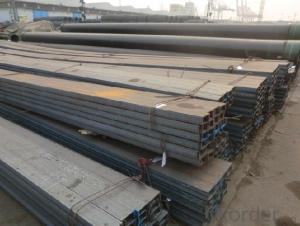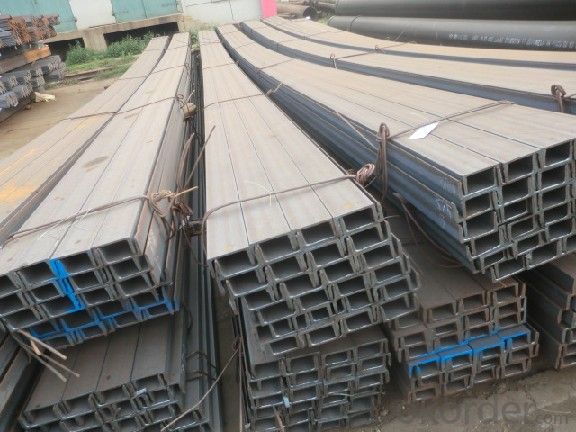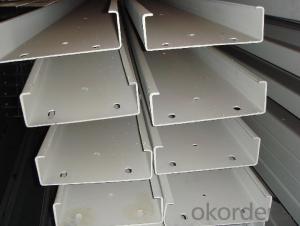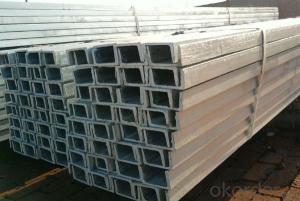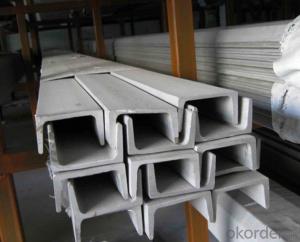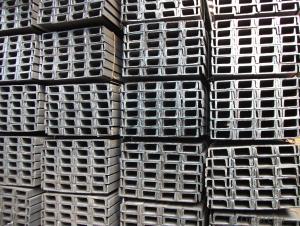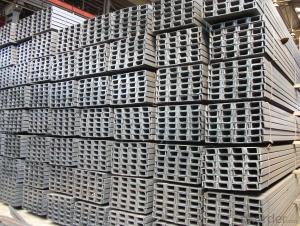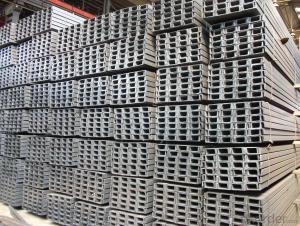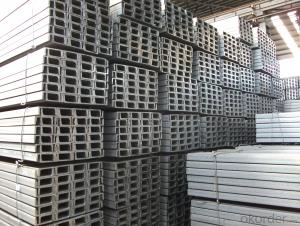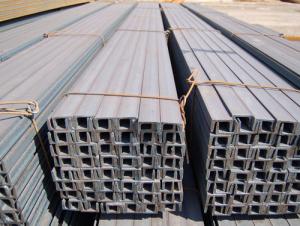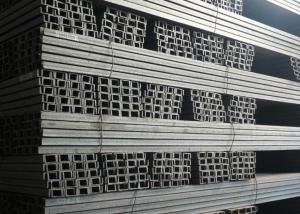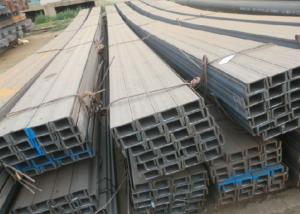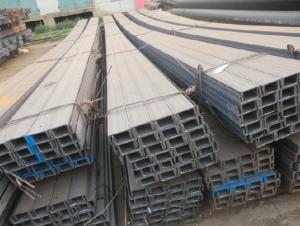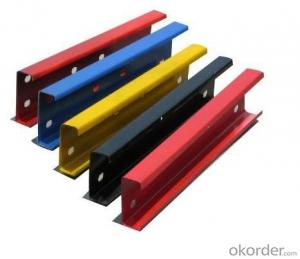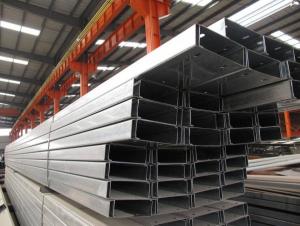CHANNEL
- Loading Port:
- China Main Port
- Payment Terms:
- TT OR LC
- Min Order Qty:
- -
- Supply Capability:
- -
OKorder Service Pledge
OKorder Financial Service
You Might Also Like
Specifications of MS Channel:
1.We supply high quality MS Channel at reasonable price, including Chinese standard, Japanese standard and so on.
Standard | GB/JIS |
Material Grade | Q235,SS400 |
Technique: | Hot Rolled |
Sizes as per chinese standard: | 50*37*4.5mm - 300*89*11.5mm |
Sizes as per japanese standard: | 50*25*3mm – 200*80*7.5mm |
Length: | 6meter, 9meter, 12meter |
Note: 1.we are also competent to provide our customers other MS Channel based on other sizes according to customer’s requirements.
2. The length of our ms channel could be cut into other meters as per customer’s requirements. For example, the channel in 6meters could be cut into 5.8meters in order to be fit in the 20ft container.
2. The detailed sections of MS Channel as per GB standard.are shown in the table-1:
GB U CHANNEL | Standard | Sectional | Dimension |
| Mass: |
| (mm) | (mm) | (mm) | (mm) |
|
50X37 | 50 | 37 | 4.50 | 7.0 | 5.438 |
63X40 | 63 | 40 | 4.80 | 7.5 | 6.634 |
80x43 | 80 | 43 | 5.00 | 8.0 | 8.045 |
|
|
|
|
|
|
100x48 | 100 | 48 | 5.30 | 8.5 | 10.007 |
120x53 | 120 | 53 | 5.50 | 9.0 | 12.059 |
140x58 | 140 | 58 | 6.00 | 9.5 | 14.535 |
140x60 | 140 | 60 | 8.00 | 9.5 | 16.733 |
|
|
|
|
|
|
160x63 | 160 | 63 | 6.50 | 10.0 | 17.240 |
160x65 | 160 | 65 | 8.50 | 10.0 | 19.752 |
|
|
|
|
|
|
180x68 | 180 | 68 | 7.00 | 10.5 | 20.174 |
180x70 | 180 | 70 | 9.00 | 10.5 | 23.000 |
|
|
|
|
|
|
200x73 | 200 | 73 | 7.00 | 11.0 | 22.637 |
200x75 | 200 | 75 | 9.00 | 11.0 | 25.777 |
|
|
|
|
|
|
220x77 | 220 | 77 | 7.00 | 11.5 | 24.999 |
220x79 | 220 | 79 | 9.00 | 11.5 | 28.453 |
|
|
|
|
|
|
250x78 | 250 | 78 | 7.00 | 12.0 | 27.410 |
250x80 | 250 | 80 | 9.00 | 12.0 | 31.335 |
250x82 | 250 | 82 | 11.00 | 12.0 | 35.260 |
|
| |
|
|
|
280x82 | 280 | 82 | 7.50 | 12.5 | 31.427 |
280x84 | 280 | 84 | 9.50 | 12.5 | 35.823 |
280x86 | 280 | 86 | 11.50 | 12.5 | 40.219 |
|
|
|
|
|
|
300x85 | 300 | 85 | 7.50 | 13.5 | 34.463 |
300x87 | 300 | 87 | 9.50 | 13.5 | 39.173 |
300x89 | 300 | 89 | 11.50 | 13.5 | 43.883 |
Table-1
3. The chemical composition of HR Channel Steel according to Q235B is shown in Table-2.
Alloy No | Grade | Element(%) | ||||
C | Mn | S | P | Si | ||
Q235 | B | 0.12-0.20 | 0.3-0.7 | ≦0.045 | ≦0.045 | ≦0.3 |
Table-2
Note: we are able to present our customers relevant SGS test report for chemical composition of HR Channel Steel.
4. The mechanical property of HR Channel Steel according to Q235B is shown in Table-3-1 and Table-3-2
Alloy No | Grade | Yielding Strength Point(Mpa) | |||
Thickness(mm) | |||||
≦16 | >16-40 | >40-60 | >60-100 | ||
≧ | |||||
Q235 | B | 235 | 225 | 215 | 205 |
Table-3-1
Alloy No | Grade | Tensile Strength(Mpa) | Elongation After Fracture(%) | |||
| | Thickness(mm) | |||||
≦16 | >16-40 | >40-60 | >60-100 | |||
≧ | ||||||
G235 | B | 375-500 | 26 | 25 | 24 | 23 |
Table-3-2
Note: we are able to present our customers relevant SGS test report for mechanical property of MS Channel as customer’s request.
Applications of MS Channel:
The MS Channel can be applied to construction of warehouses, workshops, sport stadiums and car parks etc.The hot rolled channel steel belongs to carbon structural steel which is applied to in the field of construction and machinery.In details, the hot rolled channel steel is usually used for arch-itechtural structure, and they could be welded in order to support or hang a vari-ety of facilities. They are also usually used in combination with I beam. Generally,the hot rolled channel steel we supply must possess perfect welding property, riveting property and mechanical property and so on.
Package & Delivery of MS Channel:
1.The hot rolled channel steel will be packed in bundle with steel wire at each end of every bundle and color marking in order to help the customer to recognize his goods more easily at sight.
2. And the hot rolled channel steel could be loaded into 20ft or 40ft container, or by bulk cargo.If the weight of each bundle reaches more than 3.5 mt, the loading by break bulk cargo should be choosed.When the weight of each bundle reaches less than 3mt, the loading by container should be choosed.
3.As for the transportaion from mill to loading port, the truck will be usually used. And the maximum quantity for each truck is 40mt.
4.All in all, we could do in accordance with customer's request
- Q: Can steel channels be used for solar panel mounting?
- Yes, steel channels can be used for solar panel mounting. Steel channels provide a strong and durable option for mounting solar panels, as they are capable of supporting the weight of the panels and withstanding various weather conditions. Additionally, steel channels can be easily customized and adjusted to fit the specific requirements of the solar panel installation. They offer a secure foundation for the panels and can be installed on rooftops, ground mounts, or other structures. However, it is important to ensure that the steel channels are properly installed and anchored to provide the necessary stability for the solar panels.
- Q: I have three houses, the length is 7 meters, the width is 4 meters, I would like to use a 4 meter trough board to do the support, and then put concrete slabs on the channel, the two floor of the roof also do so, can I do that? If it is possible to use a large trough plate, a thick concrete slab, and a thick steel bar for concrete slabs Thank you
- The concrete of channel steel is made of concrete and steel bar. This kind of floor has the advantages of firmness, durability, rigidity, high strength and good fire resistance, and is widely used at present. According to the construction method, it can be divided into two major categories: cast-in-place reinforced concrete floor and prefabricated reinforced concrete floor.
- Q: Are steel channels suitable for corrosive environments?
- Depending on the specific conditions and the type of steel used, steel channels may be a viable option for corrosive environments. For instance, stainless steel channels possess a high level of resistance to corrosion thanks to their significant chromium content. They can endure exposure to moisture, chemicals, and other corrosive substances without undergoing deterioration. Conversely, carbon steel channels may not be as well-suited for corrosive environments since they are more susceptible to rust and corrosion. In such instances, additional protective measures such as coatings or galvanization might be necessary in order to prevent corrosion. Ultimately, the appropriateness of steel channels for corrosive environments will hinge upon the specific application and the selected type of steel. Therefore, it is crucial to consult experts or engineers to ascertain the optimal material for a given corrosive environment.
- Q: How do steel channels contribute to the overall strength of a building?
- Steel channels contribute to the overall strength of a building by providing structural support and reinforcement. They are commonly used in construction to transfer loads and distribute weight evenly across different parts of the structure. Steel channels help to prevent sagging, bending, and collapse by increasing the stability and rigidity of the building. Additionally, they enhance the building's resistance to lateral forces such as wind or earthquakes, making it more durable and structurally sound.
- Q: What is the difference between channel steel and C steel?
- Section C is produced by cold rolling of strip steel, which is generally supplied by steel structure and thinner in thickness. In addition, their cross-section is not the same, the channel is straight side, C steel is curling.
- Q: Are steel channels suitable for use in telecommunications towers?
- Yes, steel channels are suitable for use in telecommunications towers. Steel channels are known for their strength and durability, making them ideal for supporting heavy loads and withstanding extreme weather conditions. Additionally, steel channels can be easily fabricated and installed, providing a cost-effective solution for constructing telecommunications towers. They also offer excellent structural stability and can be designed to meet specific height and load requirements. Moreover, steel channels have a long lifespan and require minimal maintenance, making them a reliable choice for telecommunications infrastructure.
- Q: What are the factors to consider when determining the appropriate length of a steel channel?
- When determining the appropriate length of a steel channel, several factors need to be considered. These factors include the intended use of the channel, the structural requirements, and the limitations imposed by manufacturing and transportation processes. Firstly, the intended use of the steel channel plays a crucial role in determining its length. The channel's purpose, whether it is for supporting beams, framing structures, or acting as a conduit, will dictate the appropriate length. It is essential to assess the specific requirements of the project and ensure that the channel's length aligns with the overall design plan. Secondly, the structural requirements of the application must be taken into account. Factors such as load-bearing capacity, deflection limits, and the need for additional support or reinforcement can influence the appropriate length of the steel channel. Engineering calculations and structural analysis should be conducted to determine the necessary dimensions and ensure the channel can withstand the anticipated forces and stresses. Furthermore, manufacturing and transportation processes have their limitations that should be considered. Steel channels are typically manufactured in standard lengths, and it is important to select a length that minimizes material waste and cost. Transportation logistics, such as the size of the delivery vehicle or the availability of suitable transportation methods, may also impact the maximum length feasible for a project. Other factors that should be considered include the installation process, fabrication requirements, and any potential future modifications. It is crucial to evaluate these aspects to ensure that the chosen length of the steel channel is practical, cost-effective, and aligns with the overall project objectives. In conclusion, determining the appropriate length of a steel channel requires considering the intended use, structural requirements, manufacturing and transportation limitations, installation process, fabrication requirements, and potential future modifications. By carefully assessing these factors, one can select a length that meets the project's needs while ensuring structural integrity and efficiency.
- Q: What is the maximum span for steel channels?
- The maximum span for steel channels depends on various factors such as the specific type and size of the channel, the load it will be subjected to, and the design requirements of the structure. Therefore, there is no one-size-fits-all answer to this question.
- Q: Can steel channels be used for signage structures?
- Yes, steel channels can be used for signage structures. Steel channels provide excellent strength and durability, making them suitable for supporting signs of various sizes and weights. They are often chosen for their ability to withstand weather conditions, ensuring the longevity of the signage structure. Additionally, steel channels allow for flexibility in design and can be easily customized to meet specific signage requirements.
- Q: I want to know what kind of steel is this type of steel, such as channel steel and die steel?
- Belong to section bar. In accordance with the different smelting quality of steel, steel is divided into ordinary steel and high quality steel. According to the current catalogue of metal products, ordinary steel can be divided into large section steel, medium section steel and small section steel. The section steel can be divided into I-beam, channel steel, angle steel, round steel and so on according to its sectional shape. Large steel: large steel, I-beam, channel steel, angle steel and flat steel are hot rolled, round bar, Fang Gang, six angle iron in addition to hot rolling, there are forging, cold drawn and so on.
Send your message to us
CHANNEL
- Loading Port:
- China Main Port
- Payment Terms:
- TT OR LC
- Min Order Qty:
- -
- Supply Capability:
- -
OKorder Service Pledge
OKorder Financial Service
Similar products
Hot products
Hot Searches
Related keywords
